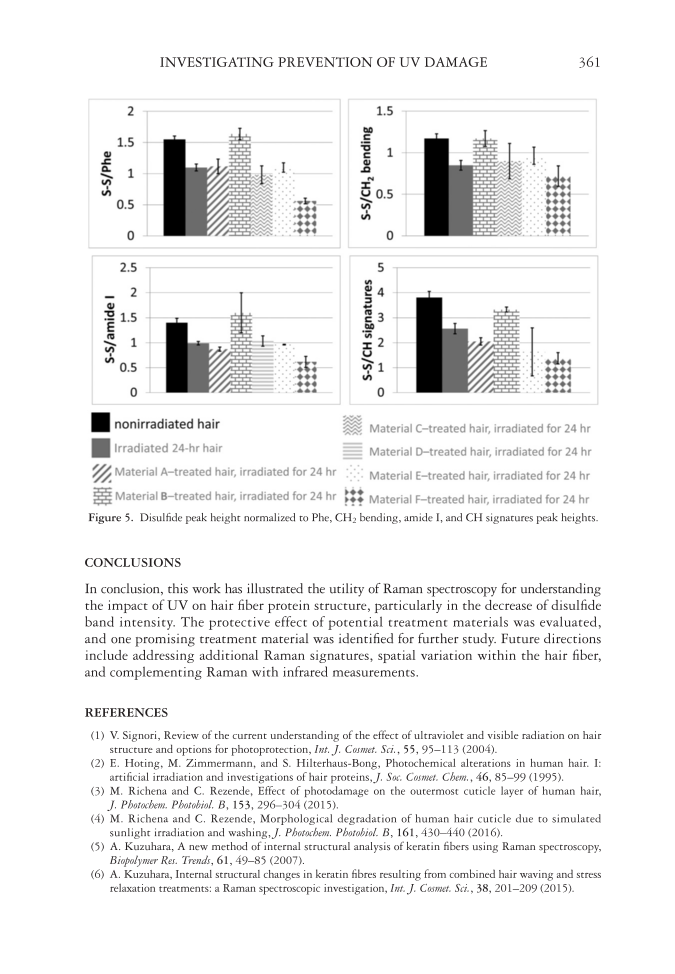JOURNAL OF COSMETIC SCIENCE 360 in the fi gure. Key differences appear with disulfi de and amide III. Disulfi de content decreases on 24-h UV exposure, indicating damage to the hair fi ber cuticle. The infl uence of UV on amide III was less clear and is not addressed in this work. As discussed in the Methods section, Raman spectra were normalized to peaks that did not change signifi cantly on 24 h of UV exposure. Because of its importance to hair fi ber structure, normalized disulfi de peak height was investigated for all treatments. Figure 5 shows the disulfi de peak height normalized to the peak height values for Phe, CH2 bending, amide I, and CH signature around 2,920 1/cm. Using all available peaks for normalization allows for analysis of hair fi bers treated with materials even if the treat- ment material Raman signature overlaps with some of the hair fi ber peaks used for normalization. Comparing the nonirradiated versus irradiated hair fi bers in Figure 5 shows a clear decrease in normalized disulfi de bond intensity, consistent with Figure 4. The treatment materials, with the exception of Material B, showed disulfi de content consistent with or lower than disulfi de content of the untreated, irradiated hair. Mate- rial B appears to show some promise for disulfi de protection. However, this protection needs to be verifi ed with a secondary method because of the peak fi tting required to separate the contribution from hair fi ber disulfi de from the raw material signature at 488 1/cm. In addition, materials A–F could potentially provide benefi ts if delivered from formulations, which were not evaluated in this work. They could potentially also have a protective effect on other measures of UV damage to hair, which were also not evaluated as part of this work. Figure 4. Ra man spectra of the cuticle of unpigmented hair fi bers that have not undergone irradiation (non- irradiated hair fi bers) and that have undergone 24 h of 62 W/m2 UV irradiation (5.4 MJ/m2).
INVESTIGATING PREVENTION OF UV DAMAGE 361 CONCLUSIONS In conclusion, this work has illustrated the utility of Raman spectroscopy for understanding the impact of UV on hair fi ber protein structure, particularly in the decrease of disulfi de band intensity. The protective effect of potential treatment materials was evaluated, and one promising treatment material was identifi ed for further study. Future directions include addressing additional Raman signatures, spatial variation within the hair fi ber, and complementing Raman with infrared measurements. REFERENCES (1) V . Signori, Review of the current understanding of the effect of ultraviolet and visible radiation on hair structure and options for photoprotection, Int. J. Cosmet. Sci., 55, 95–113 (2004). (2) E . Hoting, M. Zimmermann, and S. Hilterhaus-Bong, Photochemical alterations in human hair. I: artifi cial irradiation and investigations of hair proteins, J. Soc. Cosmet. Chem., 46, 85–99 (1995). (3) M . Richena and C. Rezende, Effect of photodamage on the outermost cuticle layer of human hair, J. Photochem. Photobiol. B, 153, 296–304 (2015). (4) M . Richena and C. Rezende, Morphological degradation of human hair cuticle due to simulated sunlight irradiation and washing, J. Photochem. Photobiol. B, 161, 430–440 (2016). (5) A . Kuzuhara, A new method of internal structural analysis of keratin fi bers using Raman spectroscopy, Biopolymer Res. Trends, 61, 49–85 (2007). (6) A. Kuzuhara, Internal structural changes in keratin fi bres resulting from combined hair waving and stress relaxation treatments: a Raman spectroscopic investigation, Int. J. Cosmet. Sci., 38, 201–209 (2015). Figure 5. Dis ulfi de peak height normalized to Phe, CH2 bending, amide I, and CH signatures peak heights.
Purchased for the exclusive use of nofirst nolast (unknown) From: SCC Media Library & Resource Center (library.scconline.org)









































































































